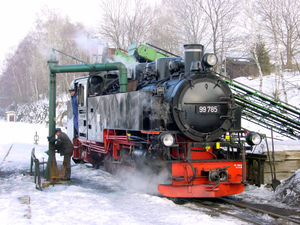- DR Class 99.77-79
-
Class 99.77–79 Number(s): 99 771–794
99 1771–99 1794 (ab 1970)Quantity: 24 Manufacturer: VEB Lokomotivbau Karl Marx, Babelsberg Year(s) of manufacture: 1952–1956 Retired: from 1976 Wheel arrangement: 2-10-2 Axle arrangement: 1’E1’ h2 Type: K 57.9 Gauge: 750 mm Length over couplers: 11,300 mm Height: 3,550 mm Overall wheelbase: 7,600 mm Empty weight: 44.0 t Service weight: 58.0 t Adhesive weight: 45.0 t Axle load: 9.0 t Top speed: 30 km/h Indicated Power: 565 PSi / 42 kW Starting tractive effort: 83.35 kN Driving wheel diameter: 800 mm Carrying wheel diameter: 550 mm Valve gear: Heusinger No. of cylinders: 2 Cylinder bore: 400 mm Piston stroke: 450 mm Boiler Overpressure: 14 bar Grate area: 2.57 m² Radiative heating area: 8.50 m² Superheater area: 27.00 m² Evaporative heating area: 76.10 m² Water capacity: 5.8 m³ Fuel: 3.6 t coal Locomotive brakes: Knorr compressed-air brake Train brakes: Hardy vacuum brake,
Heberlein brake no longer providedThe steam locomotives of DR Class 99.77–79 were ordered by the Deutsche Reichsbahn in East Germany after the Second World War. They were narrow gauge locomotives with a 750 mm rail gauge and were built for the narrow gauge lines in Saxony. The locomotives were largely identical to the DRG Class 99.73–76 standard locomotives (Einheitslokomotiven) built in the 1930s. To differentiate them from their predecessors they were described as Neubaulokomotiven or newly-designed engines.
Contents
History
After the Second World War quite a number of the most modern and most powerful narrow gauge locomotives were confiscated by the Soviet occupying powers as war reparations and transported off to the east. That led to a permanent shortage of locomotives on the Saxon narrow gauge lines, not least because the transportation requirement had grown considerably due to the mining of uranium in the Ore Mountains by the firm of Wismut AG. As a result the VEB Lokomotivbau Karl Marx were tasked with the development of a new locomotive in 1950. This was based heavily on the Einheitslokomotive of DRG Class 99.73–76 designed in the 1930s. From 1952 to 1957 a total of 24 locomotives were delivered. They were given running numbers 99 771 to 99 794. The engines were homed in the locomotive depots (Bahnbetriebswerken or Bw) of Thum and Wilsdruff.
In the late 1980s the first locomotives had to be withdrawn due to serious damage to the locomotive frame and boiler. Initially it was intended to replace all locomotives by new diesel locomotives from 1995 onwards. However, on the reunification of Germany, all such plans in the GDR were cancelled. As a result, the repair shops (Reichsbahnausbesserungswerk or RAW) responsible, RAW Meiningen and RAW Görlitz-Schlauroth, built new frames and boilers for 14 locomotives in 1991/1992 in order to keep the engines in working order.
Today the engines continue to work all the traffic on their original routes. Additional locomotives may also be found today on the island of Rügen in the Baltic Sea working the Rügen railway (Rügenschen Kleinbahnen). One locomotive, no. 99 788, was sold to the museum railway from Warthausen to Ochsenhausen in Baden-Württemberg, the so-called Öchsle, and operates there.
Technical features
In accordance with modern construction principles of the time, the locomotives are of a fully welded design.
In contrast to their predecessors the machines were given a plate frame. Like them, however, the third axle is driven and the carrying axles are housed in a Bissel bogie. Two vacuum injectors form the feed water system. In order to enable brown coal firing, the grate area was increased compared with that of the Einheitslok.
The vehicles could carry up to 5.8 m³ of water and 3.6 tonnes of coal.
Duties
The first area of operations were the Thumer Netz network with the Schönfeld-Wiesa–Thum–Meinersdorf and Wilischthal–Thum lines, the Cranzahl– Oberwiesenthal spa town route (Fichtelberg Railway) and the Freital-Hainsberg–Kipsdorf spa town line (Weisseritz Valley Railway). Several locomotives were also stationed in Thuringia on the Truse Railway.
After the closure of the Thum network in the early 1970s the locomotives were transferred to the Lößnitzgrund Railway (Radebeul Ost–Radeburg). Not until the 1980s did some locomotives end up on the Rügenschen Schmalspurbahn and Zittau network, in order to alleviate the shortage of engines there.
Literature
- Ebel, Jürgen U. and Seiler, Bernd. Die Baureihe 99.73–79 – Einheitslok auf schmaler Spur, EK-Verlag, Freiburg, 1994, ISBN 3-88255-119-4
- Wagner, Wolfram and Scheffler, Reiner. Die sächsische VII K. Die Geschichte der Baureihe 99.73–79, Bufe-Fachbuchverlag, Egglham, 1993, ISBN 3-922138-47-0
- Endisch, Dirk. Bauureihe 99.77–79, Edition 1, transpress Verlag, Stuttgart, 2001, ISBN 3-613-71178-8
Gallery
-
99 782 of the Rugen island railway (RüKB)
See also
External links
- There is a relevant English-language forum at Railways of Germany
Classes of German steam locomotives Deutsche Bundesbahn (DB) Neubaulok classes 
Deutsche Bundesbahn (DB) Umbaulok (rebuild) classes Deutsche Reichsbahn (DR) Neubaulok classes Deutsche Reichsbahn (DR) Rekolok classes Deutsche Reichsbahn-Gesellschaft (DRG) classes Categories:- Steam locomotives of Germany
- 2-10-2T locomotives
- Deutsche Reichsbahn (East Germany) locomotives
- Railway locomotives introduced in 1952
Wikimedia Foundation. 2010.



